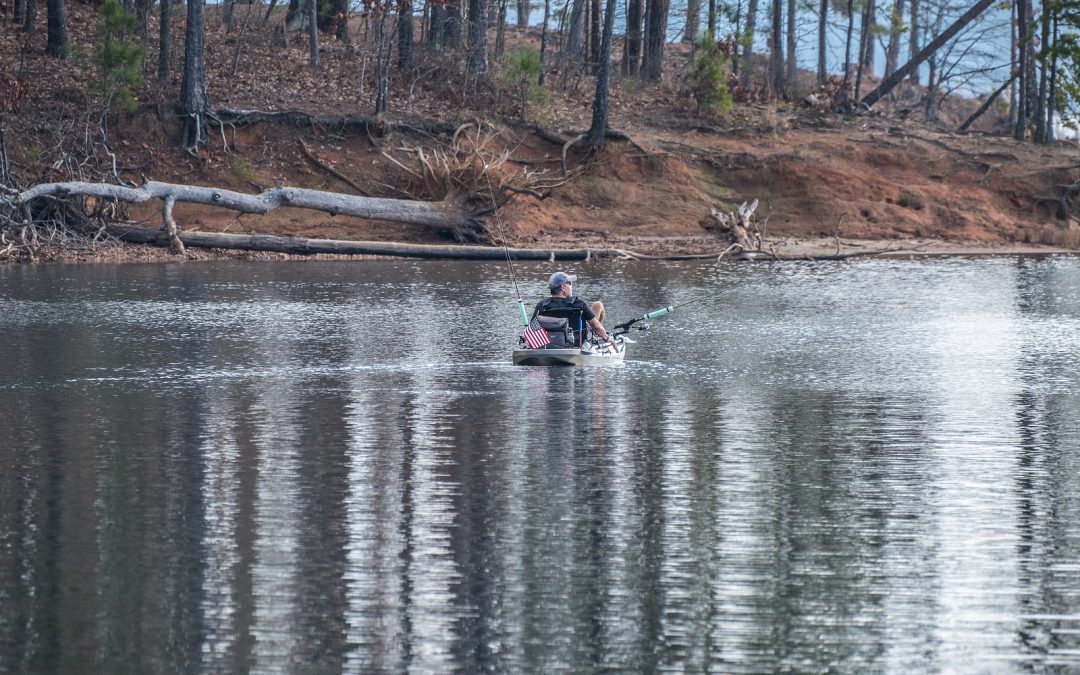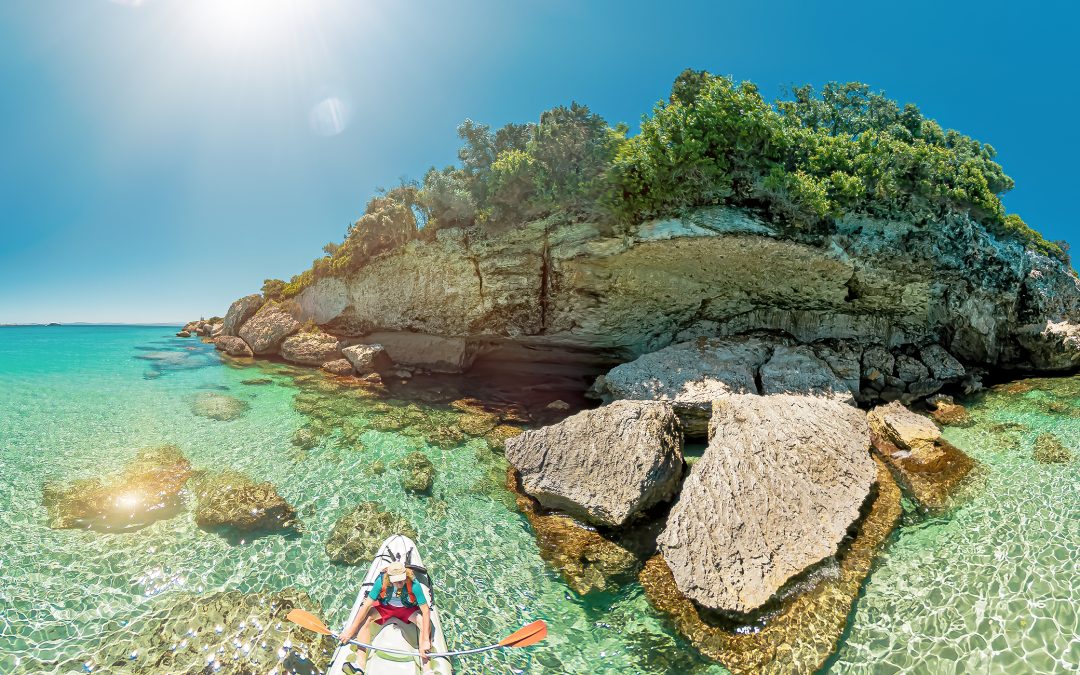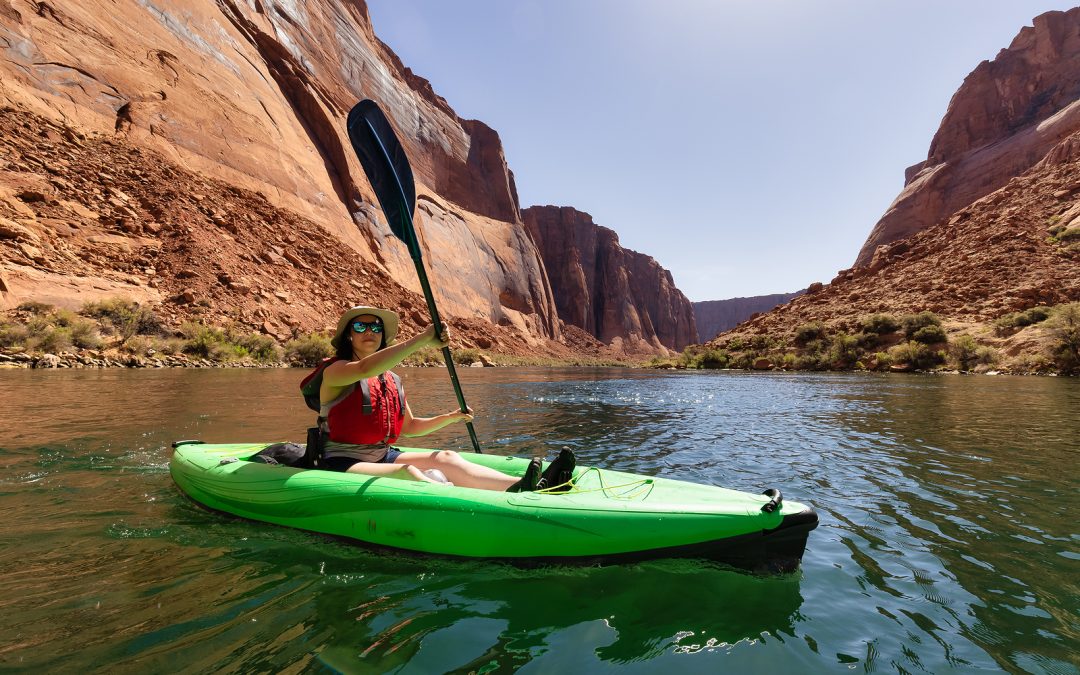Kayaking is a water sport that lets you glide across the surface of lakes, rivers, and oceans. You sit in a small boat called a kayak and use a paddle with blades on both ends to move through the water.

People kayak for many reasons. Some enjoy the peace of paddling on a calm lake. Others seek the thrill of racing down rapids.
Kayaking can be a great way to explore nature, get exercise, or spend time with friends and family.
The sport has a rich history. Indigenous peoples in the Arctic regions invented kayaks thousands of years ago for hunting and transportation.
Today, kayaks come in many shapes and sizes. They’re made from modern materials like plastic and fiberglass.
Key Takeaways
- Kayaking is a versatile water sport that can be enjoyed in various settings, from calm lakes to fast-moving rivers
- Proper equipment and basic techniques are essential for a safe and enjoyable kayaking experience
- Kayaking offers both physical and mental health benefits, including improved fitness and stress relief
History of Kayaking
Kayaking has deep roots in human history. The first kayaks were created by indigenous Arctic peoples over 4,000 years ago. These early boats were made for hunting and transportation in harsh northern climates.
The word “kayak” comes from Inuit languages and means “man’s boat”. Early kayaks were crafted from animal skins stretched over wood or whalebone frames. They were designed to be light, fast, and easy to maneuver in icy waters.
Over time, kayaking spread beyond the Arctic. In the 1800s, Europeans began using kayaks for sport and recreation. Kayak designs evolved as new materials became available.
In the 20th century, kayaking grew into a popular outdoor activity worldwide. Modern kayaks are made from plastics, composites, and other lightweight materials. They come in many styles for different uses:
- Recreational kayaks
- Whitewater kayaks
- Sea kayaks
- Fishing kayaks
Today, kayaking is enjoyed as both a leisure activity and competitive sport. It’s used for everything from peaceful lake paddling to tackling challenging rapids. The sport continues to evolve with new designs and technologies.
Types of Kayaking
Kayaking offers diverse experiences on water. Different kayak types suit various environments and skill levels. Paddlers can explore oceans, rivers, lakes, and more.
Sea Kayaking
Sea kayaking takes place in coastal waters and open seas. These kayaks are long and narrow for speed and efficiency. They have closed decks to keep water out in rough conditions.
Sea kayaking allows for extended trips and exploration of coastlines. Paddlers often carry camping gear for multi-day adventures.
Sea kayaks have special features like rudders or skegs for tracking. They also have storage compartments for equipment and supplies.
This type requires skills in navigation, weather reading, and self-rescue. Paddlers must be prepared for changing ocean conditions and potential emergencies.
Whitewater Kayaking
Whitewater kayaking happens on fast-moving rivers with rapids. These kayaks are short and highly maneuverable.
They have rounded hulls and edges to bounce off rocks. Whitewater kayaks also feature tight cockpits for a secure fit.
This type involves navigating through rapids, drops, and obstacles. Paddlers use techniques like eddy turns, ferrying, and rolling.
Whitewater racing is a competitive form of this kayaking style. It includes events like slalom and downriver racing.
Safety is crucial in whitewater kayaking. Proper gear and training are essential for handling challenging river conditions.
Touring Kayaking
Touring kayaks are designed for longer trips on various water bodies. They balance speed and stability for efficient paddling over distances.
These kayaks have more storage space than recreational models. This allows paddlers to carry camping gear and supplies for multi-day trips.
Touring kayaks often have rudders or skegs for improved tracking. They perform well in different water conditions, from calm lakes to coastal areas.
This type suits paddlers who enjoy exploring new waterways. It requires some skill in navigation and trip planning.
Touring kayaks come in both sit-inside and sit-on-top designs. The choice depends on personal preference and intended use.
Recreational Kayaking
Recreational kayaking is perfect for beginners and casual paddlers. These kayaks prioritize stability and ease of use over speed.
They are wider and shorter than touring or sea kayaks. This design makes them more stable and easier to maneuver.
Recreational kayaks are great for calm waters like lakes and slow-moving rivers. They’re ideal for short trips, fishing, or leisurely paddling.
Many recreational kayaks have open cockpits for easy entry and exit. Some feature sit-on-top designs, which are popular for warmer climates.
This type requires minimal skill to get started. It’s an accessible way to enjoy time on the water and explore local waterways.
Kayaking Equipment
Kayaking requires specific gear for safety and enjoyment on the water. The right equipment ensures a smooth and secure paddling experience.
Kayaks
Kayaks come in various types to suit different water conditions and purposes. Recreational kayaks are wide and stable, perfect for calm lakes and slow-moving rivers. Touring kayaks have a longer, narrower design for extended trips and rougher waters.
Sit-on-top kayaks offer easy entry and exit, ideal for warm weather and beginners. Inflatable kayaks provide portability and storage convenience.
Kayak materials vary, affecting weight, durability, and price. Plastic kayaks are affordable and durable. Fiberglass and composite kayaks are lighter but more expensive.
When choosing a kayak, consider your skill level, intended use, and storage space.
Paddles
Paddles are essential for propelling and steering kayaks. They consist of a shaft and two blades.
Key factors in paddle selection:
- Length: Based on paddler height and kayak width
- Material: Aluminum, fiberglass, or carbon fiber
- Blade shape: Wider for power, narrower for efficiency
- Feather angle: Blade offset for reduced wind resistance
Lightweight paddles reduce fatigue during long trips. Some paddles feature adjustable feather angles for customization.
A spare paddle is recommended for safety in case of loss or damage.
Personal Flotation Devices
Personal Flotation Devices (PFDs) are crucial for kayak safety. They provide buoyancy in case of capsizing or falling overboard.
Types of PFDs for kayaking:
- Type III: Most common, allows arm movement
- Type V: Inflatable, compact but require maintenance
Features to consider:
- Fit: Snug but comfortable
- Pockets: For storing small items
- Reflective tape: Increases visibility
PFDs should be Coast Guard approved and worn at all times while kayaking. Choose a bright color for better visibility on the water.
Safety Gear
Safety gear is vital for kayaking preparedness. Essential items include:
- Whistle: For signaling in emergencies
- Bilge pump: Removes water from the kayak
- Spray skirt: Keeps water out of the cockpit
- First aid kit: For treating minor injuries
- Dry bag: Keeps important items waterproof
Additional safety items:
- Throw bag: For rescue situations
- Knife: Useful for cutting tangled lines
- Navigation tools: Map, compass, or GPS
Always check local regulations for required safety equipment. Carry a mobile phone in a waterproof case for emergencies.
Proper safety gear enhances the kayaking experience and prepares paddlers for unexpected situations.
Basic Kayaking Techniques
Learning proper kayaking techniques is key for safety and enjoyment on the water. These skills help paddlers control their kayak and handle various conditions.
Paddling Strokes
The forward stroke is the most basic and common kayak stroke. To do it, reach forward with the paddle, dip it in the water, and pull back along the side of the kayak. Keep your arms mostly straight and rotate your torso for power.
The sweep stroke turns the kayak. Reach out to one side and make a wide arc with the paddle. For a right turn, sweep on the left side of the kayak.
The reverse stroke moves the kayak backward. It’s like the forward stroke in reverse – start at the back and push the water forward.
Draw strokes move the kayak sideways. Reach out to the side and pull the water toward you.
Launching and Landing
To launch a kayak, float it in shallow water with the bow facing away from shore. Put one paddle blade under the deck line in front of the cockpit. Stand over the kayak, straddling the cockpit.
Lower yourself into the seat and slide your legs in. Push off with your hands or paddle to move into deeper water.
For landing, paddle toward shore at an angle. As you reach shallow water, swing your legs out and stand up carefully. Hold the kayak to keep it from drifting away.
Bracing and Rolling
Bracing helps prevent capsizing. For a low brace, hold the paddle horizontally with the back of the blade on the water’s surface. Lean on it for support if you start to tip.
The high brace is similar but with the paddle held higher. It offers more support but is harder to do.
Rolling is an advanced skill to right a capsized kayak without exiting. It involves a hip snap and paddle sweep motion. This takes practice and is best learned with an instructor.
Beginners should focus on wet exits – getting out of the kayak if it flips – before learning to roll.
Navigation and Weather Considerations
Always check the weather forecast before your trip. Wind speed and direction greatly impact kayaking conditions.
Avoid going out in strong winds or storms.
Tides and currents are important factors for coastal kayaking. Get tide charts and plan your trip around the best times to paddle.
Bring navigation tools like maps, a compass, or a GPS device. Know how to use them before setting out.
It’s easy to get disoriented on the water, especially in areas with many islands or inlets.
Essentials for Kayaking Trips
Pack these key items for your kayaking adventure:
- Life jacket (required by law)
- Paddle and spare paddle
- Sun protection (hat, sunscreen, sunglasses)
- Water and snacks
- First aid kit
- Dry bag for electronics and extra clothes
- Bilge pump or sponge to remove water from the kayak
Dress for the water temperature, not the air temperature. Wear quick-drying clothes and bring extra layers in case you get wet.
Don’t forget to inform someone on land about your trip plans and expected return time. This safety measure can be crucial in emergencies.
Environmental Considerations and Conservation

Kayaking lets people enjoy nature up close. But it’s important to do it in a way that protects the environment.
Paddlers should minimize their impact on wildlife and ecosystems. This means keeping a safe distance from animals and not disturbing plants.
Kayakers can help keep waterways clean by:
• Picking up trash
• Using biodegradable soap
• Disposing of waste properly
It’s best to stick to marked trails and landing spots. This prevents damage to sensitive shorelines and habitats.
Choosing eco-friendly gear matters too. Some companies make kayaks from recycled materials. Others use sustainable manufacturing processes.
Many paddlers take part in local conservation efforts. They may join cleanup events or report wildlife sightings.
Learning about the areas you paddle in helps protect them. Kayakers can study local ecosystems and endangered species.
Kayaking Safety

Staying safe while kayaking requires preparation and awareness. Key safety measures include understanding water conditions, knowing rescue techniques, and preventing temperature-related health issues.
Understanding Water Conditions
Water conditions play a crucial role in kayaking safety. Before heading out, check weather forecasts and potential hazards. River currents, tides, and wind can greatly impact kayaking difficulty.
Learn to read water features like eddies, waves, and hydraulics. These can affect your kayak’s stability and direction.
Pay attention to water temperature too. Cold water poses risks even on warm days.
Always wear a properly fitted life jacket. It’s your most important piece of safety gear. Bright colors help rescuers spot you easily.
Rescue Techniques
Knowing how to rescue yourself and others is vital. Practice self-rescue techniques like the “wet exit” and how to re-enter your kayak from the water.
Learn the “T-rescue” to help other kayakers who have capsized.
Carry a whistle and signaling device for emergencies. A paddle float can help you get back into your kayak if you flip over. Don’t kayak alone, especially as a beginner.
Practice these skills in calm, safe conditions before attempting more challenging waters. Regular practice keeps your rescue skills sharp.
Hypothermia and Heat Exhaustion Prevention
Both cold and hot conditions pose risks to kayakers. To prevent hypothermia, dress for water temperature, not air temperature. Wear layers of quick-drying, insulating clothing.
Bring dry clothes in a waterproof bag. If you get wet, change immediately to avoid rapid body heat loss.
Know the signs of hypothermia: shivering, confusion, and loss of coordination.
For hot weather, prevent heat exhaustion by staying hydrated. Wear loose, light-colored clothing and a wide-brimmed hat. Take breaks in shaded areas. Apply sunscreen to protect your skin.
Know the symptoms of heat exhaustion: headache, dizziness, and nausea. If you experience these, get to a cool place and hydrate.
Physical and Mental Benefits of Kayaking

Kayaking offers many health perks for both the body and mind. It’s a fun way to get fit and feel good.
Kayaking is a full-body workout that builds strength in the arms, upper body, and core muscles. Paddling helps improve balance and coordination.
This water sport can boost heart health and burn calories. It’s gentle on the joints, making it a good choice for people of all ages.
Kayaking also helps the mind. Being out on the water can reduce stress and improve mood. The brain releases feel-good chemicals during exercise.
Spending time in nature while kayaking can be calming. It gives people a chance to unplug from daily life and enjoy peaceful surroundings.
Social benefits are another plus. Kayakers can meet new friends and bond with others who share their interest.
Kayaking builds confidence as people learn new skills and overcome challenges on the water. It can be a source of pride and accomplishment.
Kayaking Communities and Culture

Kayaking has a rich cultural history dating back thousands of years. The Inuit, Yupik, and Aleut tribes created the first kayaks over 4,000 years ago for hunting and transportation in Arctic regions.
Today, kayaking communities exist worldwide, bringing together people who share a passion for paddling. These groups often organize:
- Regular meetups and outings
- Skills workshops
- River cleanups
- Conservation efforts
Kayaking clubs provide a space for enthusiasts to connect, learn, and explore together. They welcome paddlers of all skill levels, from beginners to experts.
The sport has also developed its own unique culture and etiquette. Kayakers often use hand signals to communicate on the water and follow a “leave no trace” philosophy to protect the environment.
Indigenous kayaking traditions remain an important part of many cultures. Some communities work to preserve these practices and educate others about their significance.
Competitive kayaking has grown into a global sport. Events range from whitewater slalom races to long-distance sea kayaking expeditions. These competitions bring together athletes from diverse backgrounds to test their skills.
Kayaking continues to evolve, with new styles and techniques emerging. The sport’s community spirit and connection to nature remain strong, attracting new enthusiasts and keeping longtime paddlers engaged.
Frequently Asked Questions

Kayaking involves specific gear, techniques, and considerations for beginners. It offers health benefits and can be used for various purposes. Here are answers to common questions about this water sport.
What essential equipment is needed for kayaking?
Kayakers need a kayak, paddle, and personal flotation device (PFD). A kayak is propelled using a double-bladed oar, allowing paddlers to navigate through water.
Other important items include a spray skirt, helmet, and appropriate clothing for water conditions. Beginners should also bring water, snacks, and sun protection.
How does kayaking differ from canoeing?
Kayaks are typically smaller and more maneuverable than canoes. Kayakers use a double-bladed paddle, while canoeists use a single-bladed paddle.
Kayaks often have a closed deck, whereas canoes have an open top. The seating position also differs, with kayakers sitting lower in the boat.
What are the health benefits of kayaking?
Kayaking provides a full-body workout, engaging muscles in the arms, shoulders, back, and core. It improves cardiovascular fitness and builds strength.
This low-impact activity also reduces stress and allows people to connect with nature. Regular kayaking can enhance balance, coordination, and flexibility.
What should beginners know before trying kayaking?
Beginners should learn basic safety rules and paddling techniques. It’s important to choose calm waters for initial practice.
New kayakers should familiarize themselves with their equipment and learn how to enter and exit the kayak safely. Taking a beginner’s course can be helpful.
In what ways can kayaking be used?
Kayaking can be used for recreation, fishing, photography, and wildlife viewing. Some people use kayaks for exercise or competitive racing.
Kayaking is a versatile activity that can be enjoyed on lakes, rivers, and oceans. It’s also used for eco-tourism and exploration of coastal areas.
How challenging is it for beginners to learn kayaking?
Kayaking basics are relatively easy to learn for most people.
With proper instruction and practice, beginners can grasp fundamental paddling techniques quickly.
To improve kayaking skills, newcomers can take courses, join paddling clubs, and practice in various water conditions.
Consistent practice helps build confidence and proficiency.










